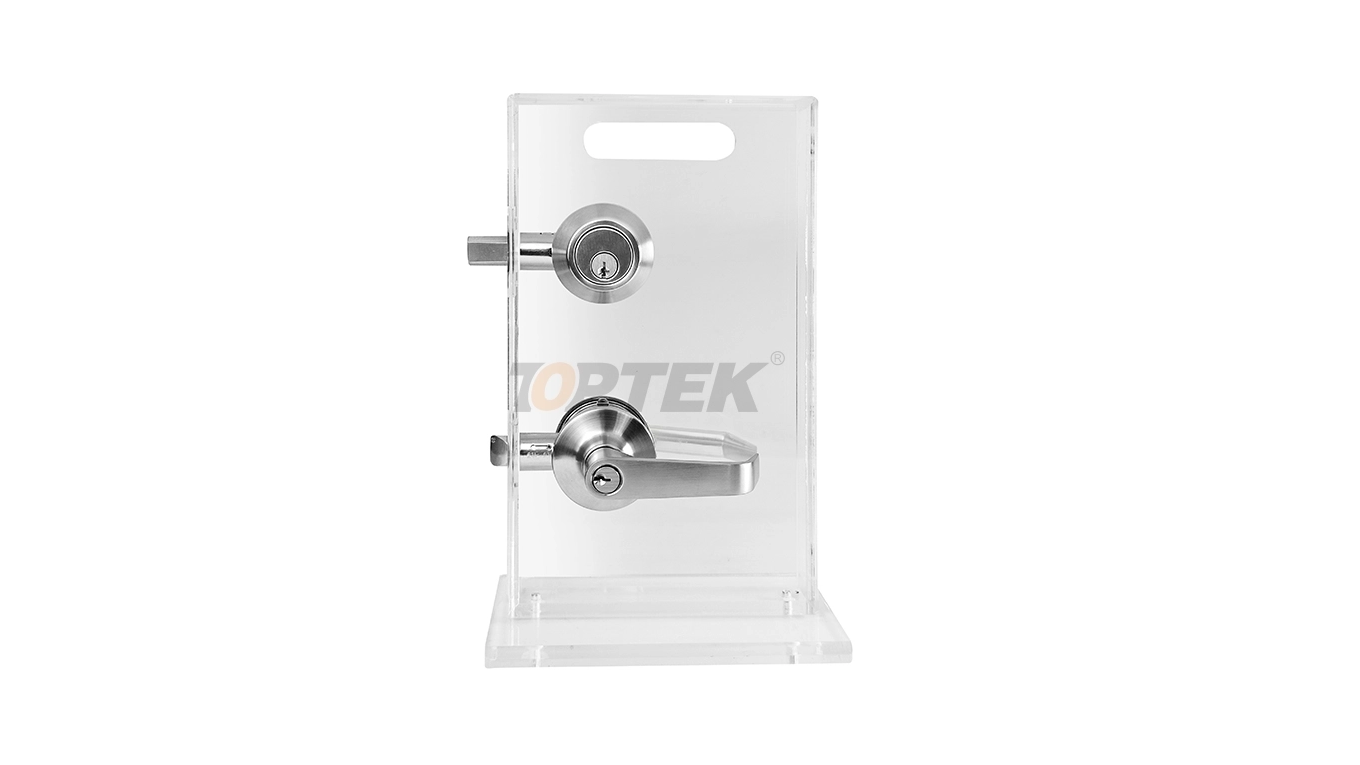Home security starts at your front door. While many homeowners rely on basic door handle locks, these offer minimal protection against determined intruders. A deadbolt lock provides the robust security your home needs, but many people don't fully understand how these essential devices work or why they're so effective.
Understanding what a deadbolt lock does can help you make informed decisions about your home's security. This guide will explain how deadbolts function, explore their key benefits, and help you choose the right type for your needs.
How Does a Deadbolt Lock Work?
A deadbolt lock operates through a simple yet highly effective mechanism. Unlike spring bolt locks found in standard door handles, a deadbolt uses a solid metal bolt that extends deep into the door frame when locked.
When you turn the key or thumb turn, it activates the lock cylinder, which rotates a cam or tailpiece. This movement drives the bolt horizontally into the strike plate mounted on the door frame. The bolt remains in this extended position until manually retracted with a key or thumb turn.
The "dead" in deadbolt refers to the bolt's inability to move on its own. Spring bolts can be pushed back into the door with enough force, but deadbolt mechanisms require deliberate action to retract. This design makes them extremely resistant to forced entry attempts.
Most deadbolt locks extend approximately one inch into the door frame, creating a strong connection between the door and frame. This extended reach distributes force across a larger area, making it much harder for intruders to break through.
Primary Functions of Deadbolt Locks
Enhanced Security Against Break-Ins
The primary function of a deadbolt lock is to provide superior security compared to standard locks. The solid metal bolt creates a strong barrier that resists common break-in methods like lock bumping, picking, and forced entry.
Deadbolts typically feature hardened steel bolts that can withstand significant force. When properly installed with a reinforced strike plate and long screws, they create a formidable obstacle for potential intruders.
Resistance to Lock Manipulation
Standard spring bolt locks are vulnerable to various manipulation techniques, including credit card attacks and lock picking. Deadbolt locks eliminate many of these vulnerabilities through their mechanical design.
The solid bolt construction and lack of spring mechanisms make deadbolts extremely difficult to manipulate without the proper key. This resistance to tampering makes them a preferred choice for exterior doors.
Peace of Mind
Beyond physical security, deadbolt locks provide psychological benefits. Knowing your home is protected by high-quality locks can reduce anxiety and help you feel more secure, especially when sleeping or away from home.
Types of Deadbolt Locks
Single Cylinder Deadbolts
Single cylinder deadbolts feature a key cylinder on the exterior side and a thumb turn on the interior. These are the most common type of deadbolt lock for residential use.
They're ideal for doors without glass panels nearby, as the thumb turn provides convenient interior access. However, if glass is present near the door, intruders could potentially break the glass and reach the thumb turn.
Double Cylinder Deadbolts
Double cylinder deadbolts require a key on both sides of the door. This design prevents intruders from unlocking the door even if they gain access to the interior side through broken glass.
While double cylinder deadbolts offer enhanced security, they can pose safety concerns during emergencies. Family members need to locate keys to exit quickly, which could be problematic during fires or other urgent situations.
Smart Deadbolts
Smart deadbolts combine traditional deadbolt security with modern convenience features. These electronic locks can be operated through smartphone apps, keypads, or biometric scanners.
Many smart deadbolts maintain mechanical backup options while adding features like remote access, entry logs, and temporary access codes for guests or service providers.

Key Benefits of Installing Deadbolt Locks
Superior Strength and Durability
Deadbolt locks are built to last. The solid metal construction resists wear and tear better than spring bolt mechanisms. Quality deadbolts can function reliably for decades with minimal maintenance.
The robust construction also means deadbolts maintain their security effectiveness over time, unlike weaker locks that may become easier to bypass as they age.
Deterrent Effect
Visible deadbolt locks can deter potential burglars before they attempt a break-in. Many intruders look for easy targets and will move on when they see quality security hardware.
The presence of deadbolt locks signals that a homeowner takes security seriously, potentially making criminals choose easier targets elsewhere.
Insurance Benefits
Many insurance companies offer discounts for homes with quality security features, including deadbolt locks. These discounts can help offset the initial investment in better door hardware.
Check with your insurance provider to understand what security improvements might qualify for reduced premiums.
Choosing the Right Deadbolt Lock
Security Ratings and Certifications
Look for deadbolt locks with ANSI/BHMA ratings. Grade 1 deadbolts offer the highest security level, suitable for commercial applications and high-security residential needs. Grade 2 deadbolts provide excellent security for most residential applications, while Grade 3 offers basic security for low-risk situations.
Material Quality
Choose deadbolts with solid metal bolts, preferably hardened steel. Avoid locks with hollow bolts or those made from soft metals that can be easily cut or broken.
The lock body should also be constructed from durable materials like solid brass or steel to resist drilling and other forced entry attempts.
Proper Installation Requirements
Even the best deadbolt lock won't provide adequate security if improperly installed. The door frame must be reinforced with a quality strike plate secured by screws at least 3 inches long that penetrate the wall framing.
Consider professional installation if you're not confident in your ability to properly mount the lock and reinforce the door frame.
Maximizing Your Home's Security
Installing a deadbolt lock is just one component of comprehensive home security. Combine deadbolts with other security measures like security cameras, motion-activated lighting, and alarm systems for maximum protection.
Regular maintenance keeps deadbolt locks functioning properly. Lubricate the mechanism periodically and check that bolts extend fully into strike plates. Replace locks if they become difficult to operate or show signs of wear.
Remember that door security is only as strong as the weakest component. Invest in solid core doors and reinforced frames to complement your quality deadbolt locks.
A deadbolt lock serves as your home's first line of defense against intruders. By understanding how these essential security devices work and choosing the right type for your needs, you can significantly improve your home's security and your family's safety.
Deadbolt Lock
Tubular Deadbolt
Tubular Latch
English
العربية
Français
Русский
Español
Português
Deutsch
italiano
日本語
한국어
Nederlands
Tiếng Việt
ไทย
Polski
Türkçe
አማርኛ
ພາສາລາວ
ភាសាខ្មែរ
Bahasa Melayu
ဗမာစာ
தமிழ்
Filipino
Bahasa Indonesia
magyar
Română
Čeština
Монгол
қазақ
Српски
हिन्दी
فارسی
Kiswahili
Slovenčina
Slovenščina
Norsk
Svenska
українська
Ελληνικά
Suomi
Հայերեն
עברית
Latine
Dansk
اردو
Shqip
বাংলা
Hrvatski
Afrikaans
Gaeilge
Eesti keel
Māori
සිංහල
नेपाली
Oʻzbekcha
latviešu
অসমীয়া
Aymara
Azərbaycan dili
Bamanankan
Euskara
Беларуская мова
भोजपुरी
Bosanski
Български
Català
Cebuano
Corsu
ދިވެހި
डोग्रिड ने दी
Esperanto
Eʋegbe
Frysk
Galego
ქართული
guarani
ગુજરાતી
Kreyòl ayisyen
Hausa
ʻŌlelo Hawaiʻi
Hmoob
íslenska
Igbo
Ilocano
Basa Jawa
ಕನ್ನಡ
Kinyarwanda
गोंगेन हें नांव
Krio we dɛn kɔl Krio
Kurdî
Kurdî
Кыргызча
Lingala
Lietuvių
Oluganda
Lëtzebuergesch
Македонски
मैथिली
Malagasy
മലയാളം
Malti
मराठी
ꯃꯦꯇꯥꯏ (ꯃꯅꯤꯄꯨꯔꯤ) ꯴.
Mizo tawng
Chichewa
ଓଡ଼ିଆ
Afaan Oromoo
پښتو
ਪੰਜਾਬੀ
Runasimi
Gagana Samoa
संस्कृत
Gaelo Albannach
Sepeti
Sesotho
chiShona
سنڌي
Soomaali
Basa Sunda
Wikang Tagalog
Тоҷикӣ
Татарча
తెలుగు
ትግንያውያን
Xitsonga
Türkmençe
संस्कृत
ئۇيغۇرچە
Cymraeg
isiXhosa
ייִדיש
Yorùbá
isiZulu





































